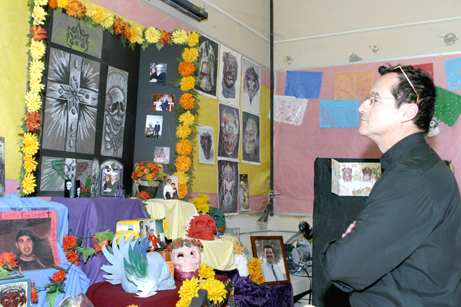
Celebration of dead mixes Aztec, Christian traditions
D
ía de los Muertos, or day of the dead, has little to do with the
frights most people associate with Halloween. Zombies, witches and
vampires, along with the dark, dank colors of the traditional
Halloween are a sharp juxtaposition to the Mexican holiday that
evolved from an ancient Aztec festival to
celebrate the dead.
Celebration of dead mixes Aztec, Christian traditions
Día de los Muertos, or day of the dead, has little to do with the frights most people associate with Halloween. Zombies, witches and vampires, along with the dark, dank colors of the traditional Halloween are a sharp juxtaposition to the Mexican holiday that evolved from an ancient Aztec festival to celebrate the dead.
While skulls and skeletons are among the icons associated with the holiday, bright colors, marigold flowers and lively songs are all part of traditional Día de los Muertos events. The holiday started long ago when Aztecs celebrated their dead for a month. In their culture, death was not seen as an end, but as the start of a new journey.
When Spaniards conquered what is now modern-day Mexico and Latin America, they tried to suppress the death celebration and eventually incorporated it into the Catholic tradition of All Saint’s Day and All Soul’s Day celebrated Nov. 1 and Nov. 2.
“As Christians, we believe in the next life,” said Rudy Ruiz, the pastor at St. Benedict’s Catholic Church. “It’s our way of saying we can face death. Death has no power over us.”
Ruiz invited church members to Calvary Cemetery Thursday to honor dead relatives and friends.
“In a way it is like making fun of death,” Ruiz said, of the traditions. “We face one of the greatest fears a human being can have. We face it with a smile and with a hope that we will all be together again.”
The tradition is meant to be joyful, which is how three San Benito High School art teachers approached it this year. Louise Roy, Louisa Toste and John Robrock assigned their students to create altars to loved ones in art class as well as sculptures of skulls or skeletons. The classes hosted an art show Oct. 29 where family and community members were invited to view their projects.
The students made altars and brought in photographs of dead family members. For Roy, the annual class assignment and art show is personal.
“I started it because my son died 13 years ago and I thought it was a really good way to remember him,” she said. “We could talk about the lossof a loved one and bring it into the art. It’s touchable and it’s not spooky.”
At first some of her students did think creating artwork with skulls and skeletons was spooky. One student started out thinking it was gross, but said in the end it wasn’t scary to her anymore.
For those who’d like to see a Día de los Muertos celebration up close, El Teatro Campesino members are putting the finishing touches on a three-day celebration at their playhouse in San Juan Bautista.
“It was a different way for me to look at death,” said Melinna Bobadilla, an ensemble member of El Teatro Campesino, who first learned about the traditions in a Chicano studies class at the University of California, Berkeley. “It is an alternative to the American or Western way to look at death as fearful and with sorrow.”
Bobadilla and Alfredo Avila are co-producing the events. They have planned an art show with altars, live music and a theater show. The events will be interactive and guests can paint sugar skulls or have their own faces painted as skeletons.
“Everyone always expects El Teatro to put on shows and do theater, but I wanted to add something else,” Bobadilla said. “I wanted to make it more of an event rather than a show and that’s why the most important aspect for me and the most rewarding was organizing the altar gallery.”
Altars that pay homage to the dead are part of the tradition. They can include photos of the dead, favorite foods or drinks for the dead and other trinkets to remember them. A few of the altars on display at El Teatro were created by youth groups in the region, including one in honor of Cesar Chavez and farm workers made by the Gilroy Cesar Chavez youth leadership group.
The event will include a variety of short theater pieces, some old and some new, performed by 15 actors and musicians.
“It is definitely a celebration and a well-rounded event,” Bobadilla said. “On Friday we are going to have Aztec dancers and we will do a traditional blessing of the altars.”
SHOW TIMES
Día de los Muertos at El Teatro Campesino, 705 Fourth St., San Juan Bautista, Fri., Nov. 3, 6 p.m., Sat. Nov. 4, 5 p.m. and Sun., Nov. 5 at 2 p.m. Tickets are $12 for adults and $10 for students/seniors and $8 for children. For more information, call 831-623-2444 or visit www.elteatrocampesino.com.
Melissa Flores can be reached at mf*****@**********ws.com.









